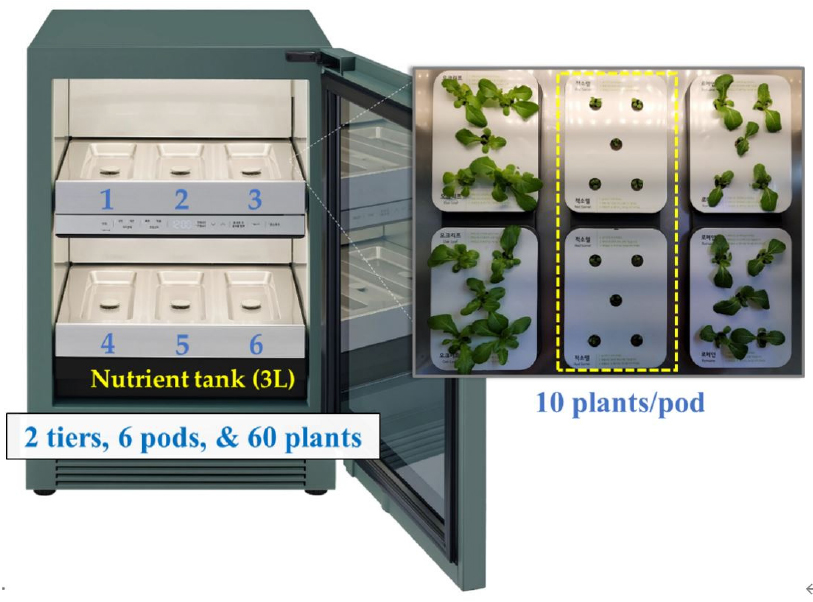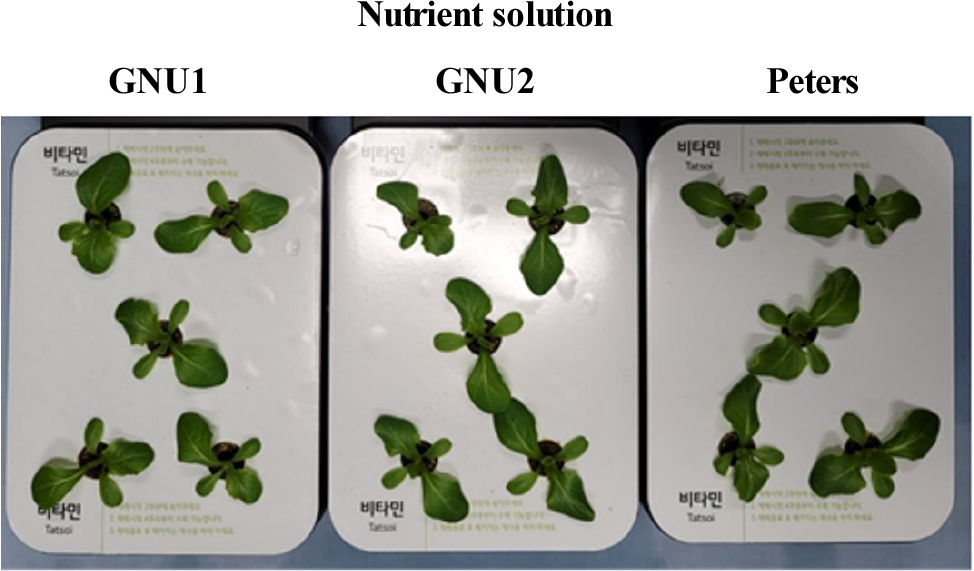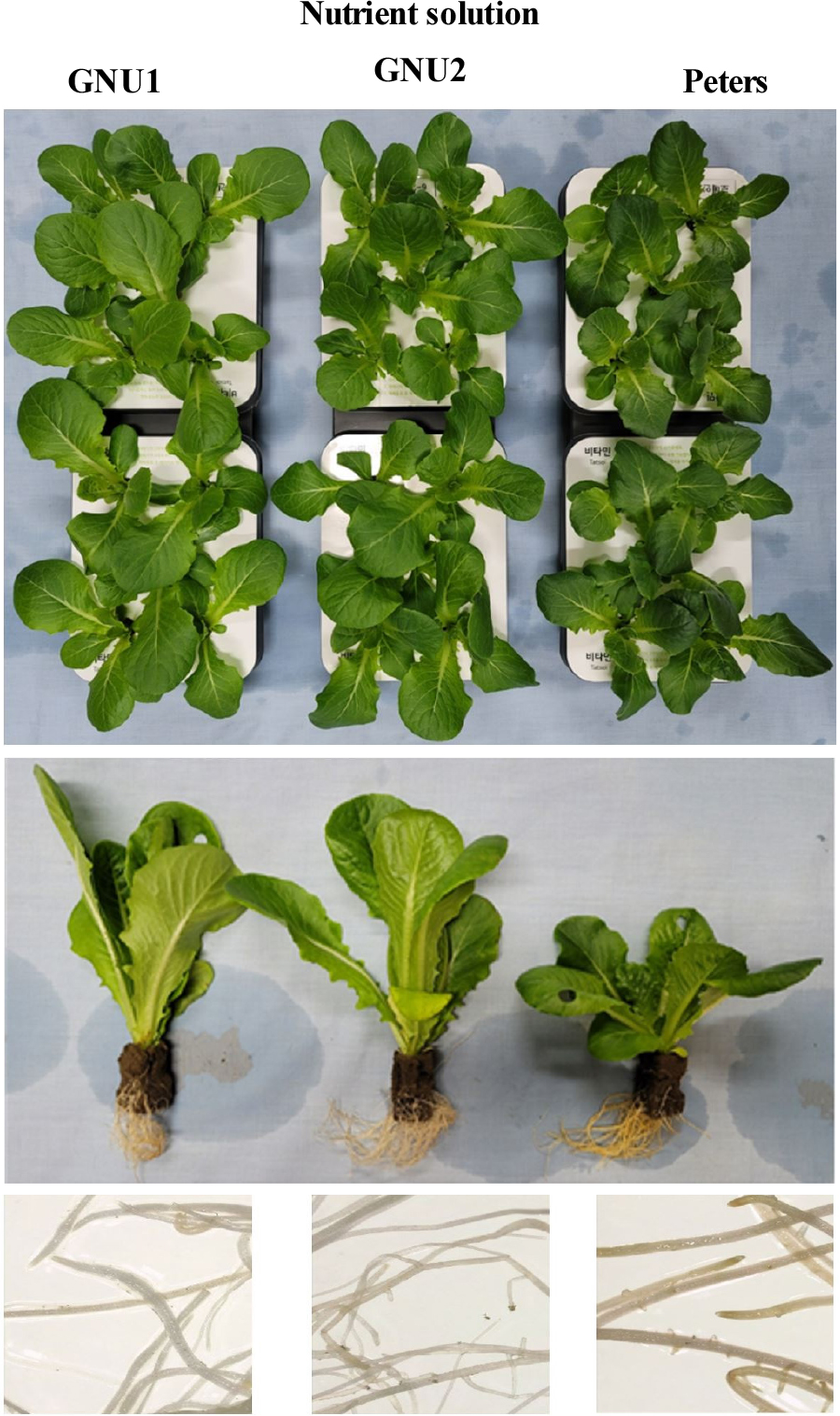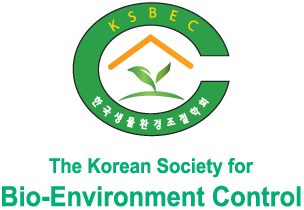서 론
최근 기후변화와 맞물려 농업이 환경에 미치는 영향이 주목받고 있다(Tudi 등, 2021). 영농활동이 기후변화에 직접적인 영향을 미치는 탓도 있지만 주변 생태계에 미치는 영향도 간과할 수 없다. 특히 농업생산성 극대화를 위해 과다 투입해왔던 비료나 양액이 주변 생태계로 유입되는 영향도 무시할 수 없는 수준에 이르렀다(Kanter 등, 2020). 경상남도의 주요 식수원 중 하나인 낙동강의 경우 독성물질 마이크로시스틴이 세계보건기구와 미국의 기준치에 상회하는 수준으로 검출되고 있는데(Jung과 Kim, 2019), 주변 농장에서 유입되는 질소와 인이 과다한 것이 이 문제의 한 원인으로 꼽힌다(Tekile 등, 2015).
이러한 환경문제에 더해 경제적 측면에서 비료 투입을 최적화할 필요가 있다. 더욱이 전 세계적으로 농업분야 인프라 산업의 어려움에 직면한 현 상황에서는 더욱 절실하다(Alexander 등, 2022). 러시아와 우크라이나 간 전쟁의 영향으로 비료 가격이 사상 최고치를 기록하고 있고(Hassen과 Bilali, 2022), 이는 글로벌 공급에 영향을 미치고 있다. 결과적으로 여러 요인들로 인해 농업 생산에 투입되는 무기 영양소의 적정량을 찾는 것이 더욱 중요해지고 있다.
식물에 공급되는 양액의 조성은 식물의 생장을 조절하는 데 매우 중요하다. 특히 질산이온(NO3−)은 작물의 필수 성분인 질소를 공급하는 데 가장 많이 이용하는 형태이다. 일반적으로 뿌리를 통해 흡수된 무기양분은 식물 체내에서 대사과정을 거쳐 활용되며 이온 형태 그대로는 거의 축적되지 않으나(Miller와 Cramer, 2005), 양액에 과다하게 공급되면 질산태 질소는 이온의 형태로 식물체에 축적되기도 한다(Maynard 등, 1976). 질소 공급원이 작물의 생산성과 품질에 영향을 미친다는 연구 결과가 많고, 질소원으로 NO3−를 100% 공급하는 것보다 NO3−에 NH4+ 이온을 혼합하여 공급하는 것이 생육에 더 낫다는 보고도 있다(Jeong과 Lee, 1990; Conesa 등, 2009; Shang과 Shen, 2018; Zhang 등, 2019). 농식품의 품질 측면에서 NO3−를 많이 공급할수록 수확한 작물은 상하기 쉽고 저장성과 맛이 떨어진다(Mengel, 1979).
또한 NO3− 및 NO2−이 채소에 많으면 중독성으로 인한 식품안전에 문제가 된다(Wolff와 Wasserman, 1972). 특히 어린이는 NO3− 중독에 더 취약한데, 이는 NO3−를 독성 물질인 NO2−로 변환하는 박테리아가 어린 아이 혹은 어린 동물의 소화 기관에서 기생할 수 있기 때문이다(Mazur, 2003). NO2−는 체내에서 산소를 운반하는 역할을 하는 헤모글로빈과 반응하여 산소를 운반하지 않는 메트헤모글로빈을 생성하여(Santamaria, 2006), 헤모글로빈이 메트헤모글로빈으로 대체됨에 따라 체내에서 운반되는 산소의 양을 감소시키며(Chamandoost 등, 2016), 이에 어린 아이 혹은 어린 동물은 점차 호흡하기 어려워진다. 이 현상을 메트헤모글로빈혈증이라고 하며 일반적으로는 ‘블루 베이비 질병’이라고 한다. 또한 질산 이온과 아질산 이온은 인체 내 반응을 통해 발암물질로 작용하기도 한다(Santamaria, 2006).
질소의 또다른 공급원인 NH4+는 식물에 독성을 유발하기도 한다. 식물이 질소를 흡수하여 아미노산으로 전환하는데 이 과정에서 에너지 소모가 가장 적은 질소원이 NH4+이다(Song 등, 2021; Clarkson과 Hanson, 1980). 그러나 NH4+가 식물 세포에 축적되면 활성산소의 생성이 증가하여 산화스트레스가 증가하고 독성을 유발할 수 있다(Esteban 등, 2016). 식물에서 NH4+ 이온의 독성 메커니즘은 복잡하고 부분적으로만 알려져 있다. 여러 연구에 따르면 암모늄 이온의 함량은 식물의 푸트레신 함량과 상관관계가 있는데(Houdusse 등, 2005) 푸트레신의 축적은 식물의 생장과 발달에 부정적인 영향을 미쳐 칼륨 누출, 단백질 손실, 조직 괴사 등을 유발한다. 결론적으로 질소원으로서 질산 이온과 암모늄 이온의 비율을 조절함으로써 식물 생육을 촉진하면서도 농식품의 안전성을 높일 수도 있다. 본 연구에서는 대표적 엽채류인 로메인상추를 대상으로 공급 양액의 무기양분의 총 함량을 낮추면서, 질소원의 적정 비율을 구명하였다.
재료 및 방법
1. 식물 재배기
본 연구는 최근에 시판되고 있는 반 밀폐형 식물재배기(Tiiun L061G1, LG Electronics Inc., Seoul, Korea)를 이용하여 수행하였다. 사용한 수경재배기의 크기(W×H×D)는 595×815×590mm이고, 무게는 68kg이었다. 내부는 2개의 층과 각 층은 다시 3개로 구획되어 총 6개의 구획으로 나뉘며(Fig. 1), 각 구획은 10개의 셀을 가진 배지(pod)와 결합되어 있었다. 양액은 재배기 하단의 탱크로부터 저면 관수로 공급하며 일정 시간 간격으로 재순환하였다. 재배 온도와 일장은 25/18°C와 14시간으로 설정하였다. 적색(32.1%), 녹색(43.7 %), 청색(19.8%)의 비율을 가진 백색 LED로 각 층에 광합성유효광양자속밀도(PPFD)를 300µmol·m-2·s-1(FLA 623 PS, ALMEMO, Holzkirchen, Germany)으로 공급하였다.
2. 식물 재료
세계적으로 이용률이 높은 대표적 엽채류인 로메인상추(Lactuca sativa L. var. longiflora ‘Caesar Green’, Asia Seed Co., Ltd., Seoul, Korea)를 실험식물로 이용하였다. 식물은 처리당 총 30주로, 하나의 pod 내에 있는 10개의 셀에 종자를 3립씩 파종하여, 파종 7일 후에 1주만 남기고 솎아내고, 솎아낸 새싹을 대상으로 초기 생육 특성을 조사하였다. 이후 파종 28일에 최종 수확하였다.
3. 양액
첫번째 실험에서는 대표적 상업용 양액인 Peters Professional (20-20-20, The Scotts Co., Marysville, OH, USA)과 경상국립대학교에서 개발한 다목적 양액(GNU 양액)을 사용하였다. GNU 양액은 실험실에서 제조하였고, 양액 강도를 2수준(GNU1과 GNU2)으로 조절하여 사용하였다. GNU1의 다량원소는 13.0N, 12.0Ca2+, 4.0Mg2+, 5.0K+, 4.0SO42−, 2.0 H2PO4−의 농도(mmol·L-1), 그리고 미량원소는 20B, 0.5Cu, 10Fe, 10Mn, 0.5Mo, 4Zn의 농도(µmol·L-1)로 공급하였다. GNU2는 양액 강도를 GNU1의 77%수준으로 공급하였다.
두번째 실험에서는 GNU1과 GNU2의 NO3− : NH4+의 비율을 100:0, 83.3:16.7, 66.7:33.3 50:50로 달리한 총 8종의 양액을 공급하였다. 질소원의 비율에 따라 양이온과 음이온의 균형 처방을 하였다. GNU1과 GNU2의 하위그룹으로 각 NO3− : NH4+의 비율에 따라 100:0은 ‘1’, 83.3:16.7은 ‘2’, 66.7:33.3은 ‘3’, 그리고 50:50은 ‘4’로 명명하였다.
4. 종자 발아
파종 다음날부터 매일 오전 9시에 종자의 발아 여부를 관찰하였고, 발아의 판정은 셀(배지) 단위로 기록하였다. 발아는 유근이 종피를 뚫고 나오는 때로, 각 셀에 파종한 3립의 종자 중 1립 이상이 발아했을 때 해당 셀의 발아가 완료된 것으로 판정하였다. 각 처리는 10셀이 1개의 반복으로, 처리당 30셀로 이루어졌으며 관찰된 데이터를 통해 발아속도(germination rate, GR), 평균발아일수(mean germination time, MGT) 및 발아세(germination energy, GE)를 계산하였다(Noh와 Jeong, 2022).
5. 생육 특성 조사와 함량 분석
파종 7일차에는 솎아낸 어린 식물을 대상으로 초기 생육으로 초장과 엽수를, 파종 28일차에 최종 수확하여 초장, 엽폭, 엽면적, 엽수, 생체중, 엽비중을 측정하였다. 초장은 근부에서부터 신초의 가장 긴 부분까지를 측정하였고, 최성엽에서 폭이 가장 넓은 부분을 엽폭으로 측정하였다. 엽비중은 직경 2 cm2의 잎 시료를 채취하여 질량을 측정하여 계산하였다(Noh와 Jeong, 2021). 엽록소 함량 측정을 위한 시료는 엽비중 측정용 시료와 동일한 방법으로 채취하여 추출용액에 침지하여 엽록소를 4°C에서 24시간 동안 추출하였다(Wang 등, 2020). 추출한 용액은 645nm와 663nm에서 분광광도계(Libra S22, Biochrom Co., Ltd., Cambridge, UK)로 흡광도를 측정하여 계산하였다(Noh와 Jeong, 2021). 뿌리 활성은 채취한 뿌리 시료(0.1g)을 0.4% tetrazolium chloride와 0.2M HCl-tris의 1:1 혼합 용액에 넣고 암 조건으로 16시간 방치한 후 색이 변한 뿌리 시료를 꺼낸 후 99% 메탄올에 24시간 침지 후 485nm에서 분광광도계(Libra S22, Biochrom Co., Ltd., Cambridge, UK)로 흡광도를 측정하여 계산하였다(Onanuga 등, 2012). 엽 조직 내 NH4+, NO2−, NO3−의 함량은 Song 등(2021)의 방식을 이용해 측정하였다.
6. 통계 분석
실험구의 배치는 실험 1에서는 3종류의 양액, 실험 2에서는 8종류의 양액 처리마다 별도의 재배기를 사용하였고, 각 처리 당 10주씩 3반복으로 완전임의 배치하였다. 실험결과의 통계분석은 SAS 프로그램(SAS 9.4, SAS Institute Inc., Cary, NC, USA)을 이용하여 분산분석(ANOVA)을 수행하였고, 평균 간 비교는 터키의 다중검정(Tukey’s multiple range test)을 이용하여 5% 유의수준에서 검증하였다.
결과 및 고찰
첫번째 실험에서는 상업용 양액 Peters(Peters Professional 20-20-20)와 GNU1, GNU2에서 재배한 식물의 생육을 비교하였다. 발아속도는 3종의 양액 간에 유의한 차이가 없었다. 평균발아일수는 GNU2와 Peters에서 1.93일로 GNU1의 2일에 비해서 유의하게 빨랐다(Table 1). 그러나 종자 발아속도가 초기생육에 영향을 미치지는 않았다. 파종 7일차의 관찰에서 외관상 차이는 나타나지 않았고(Fig. 2) 생육조사에서도 초장과 엽수에서 모두 유의한 차이가 없었다(Fig. 3).
Table 1.
Germination rate, mean germination time, and germination energy of Romaine lettuce as affected by nutrient solutions in the experiment 1.
| Nutrient solution |
Germination rate (seeds per day) |
Mean germination time (day) | Germination energy (GEnz) (%) | |
| GE2 | GE3 | |||
| GNU1y | 7.8 | 2.00 ax | 6.7 | 90.0 b |
| GNU2 | 7.8 | 1.93 b | 3.3 | 100.0 a |
| Peters | 7.8 | 1.93 b | 3.3 | 100.0 a |

Fig. 3.
Shoot length, and number of leaves of Romaine lettuce at 7 days after sowing as affected by the nutrient solution in the experiment 1. The vertical bars represent the SEs of 30 biological replicates (n = 5). Significant differences among treatments are indicated by lowercase letters at p ≤ 0.05 according to the Duncan’s multiple range test.
양액의 EC를 측정하였을 때, GNU1이 가장 높았고, 그 다음은 GNU2와 Peters 순이었다(Fig. 4). 파종 28일차에 최종 수확하여 외관을 관찰했을 때, 3양액 중 특히 Peters를 이용하여 재배한 식물에서 다른 처리에 비해 엽 조직이 두껍고, 초장과 엽장이 짧았다(Fig. 5). 또한 뿌리를 현미경으로 관찰하였을 때, 이 처리에서는 GNU1과 GNU2에 비해 색이 짙고 뿌리털의 길이가 충분히 생장하지 못하고 짧은 특성을 보였다(Fig. 5).

Fig. 4.
Mean pH (a) and EC (b) of the nutrient solution measured for 28 days during the experiment period. Peters, GNU1, and GNU2 are the nutrient solutions used in the experiment, and Peters is the commercial nutrient solution. When the pH was out of range 5.6-6.4, it was adjusted to 6.0 (blue line). The vertical bars represent SEs replicates (n = 28). Significant differences among treatments are indicated by lower case letters at p ≤ 0.05 according to the Duncan’s multiple range test.
생육조사에서도 외관 관찰과 유사한 결과가 나타났다. 초장, 엽폭, 엽면적, 엽수, 생체중은 GNU1과 GNU2로 재배한 식물이 Peters에서 재배한 것에 비해 유의하게 크거나 많았다(Fig. 6). Peters에서 재배한 식물은 GNU2 처리에 비해 초장은 53.3%, 엽폭은 66.7%, 엽면적은 42.9%, 엽수는 77.8%, 생체중은 31.3%에 그쳤다(Fig. 6). 한편 GNU1과 GNU2 처리에서는 생체중 이외의 생육에서는 유의한 차이가 없었으며, 생체중은 GNU2에서 가장 무거웠고, GNU1에서는 GNU2에 비해 80% 수준을 보였다(Fig. 6).
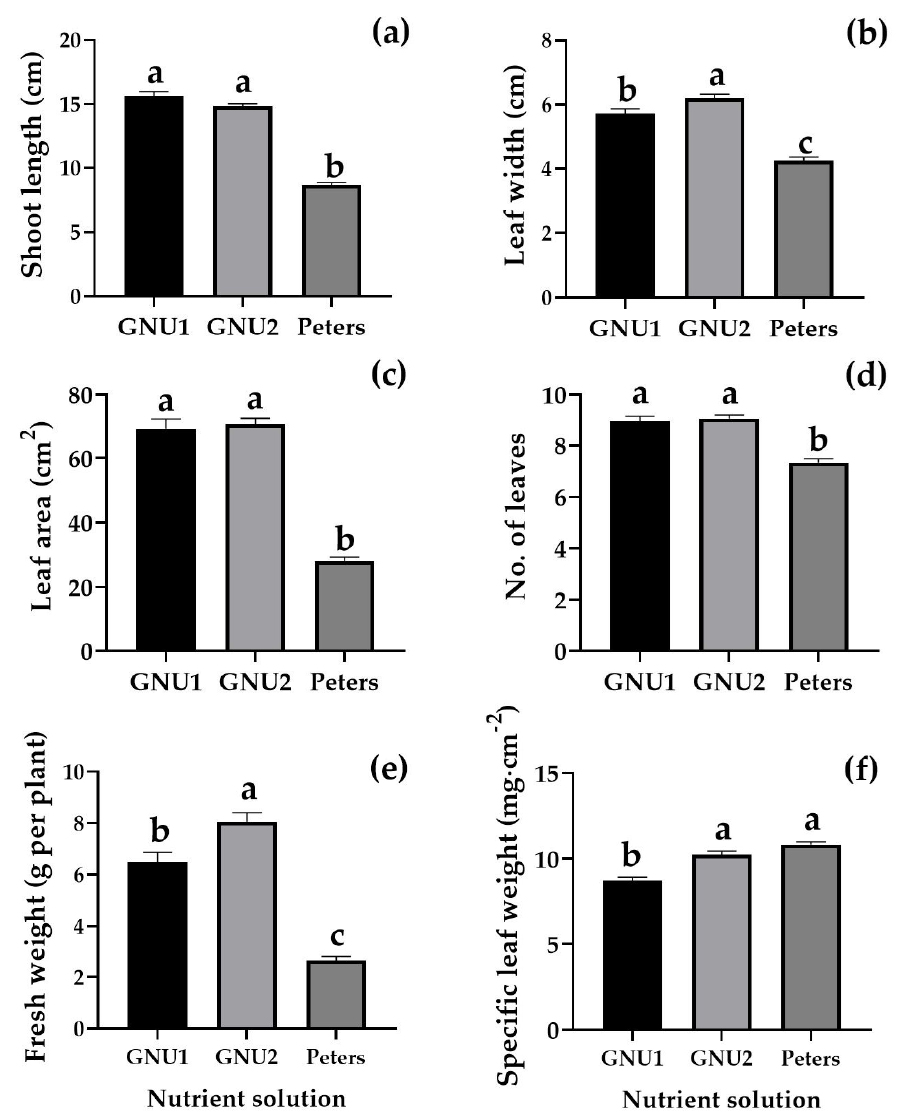
Fig. 6.
Shoot length (a), leaf width (b), leaf area (c), and number of leaves (d) of Romaine lettuce at 28 days after sowing as affected by the nutrient solution in experiment 1. The vertical bars represent the SEs of 30 biological replicates (n = 30). Significant differences among treatments are indicated by lowercase letters at p ≤ 0.05 according to the Duncan’s multiple range test.
엽록소a와 엽록소b의 함량은 양액 종류 간에 유의한 차이가 없었다. 아스코르브산(AA)와 탈수소아스코르브산(DHA)의 함량도 양액 처리 간의 유의한 차이가 없었다(Fig. 7). 조직 내 NH4+의 함량은 GNU1과 GNU2에서 재배한 식물에 비해 Peters에서 재배한 식물에서 유의하게 높았다(Fig. 8).

Fig. 7.
Contents of chlorophylls a and b (a), and ascorbic acid (AA) and L-dehydroascorbic acid (DHA) (b) of Romaine lettuce at 28 days after sowing as affected by nutrient solution in experiment 1. Peters, GNU1, and GNU2 are the nutrient solutions used in the experiment, and Peters is the commercial nutrient solution.
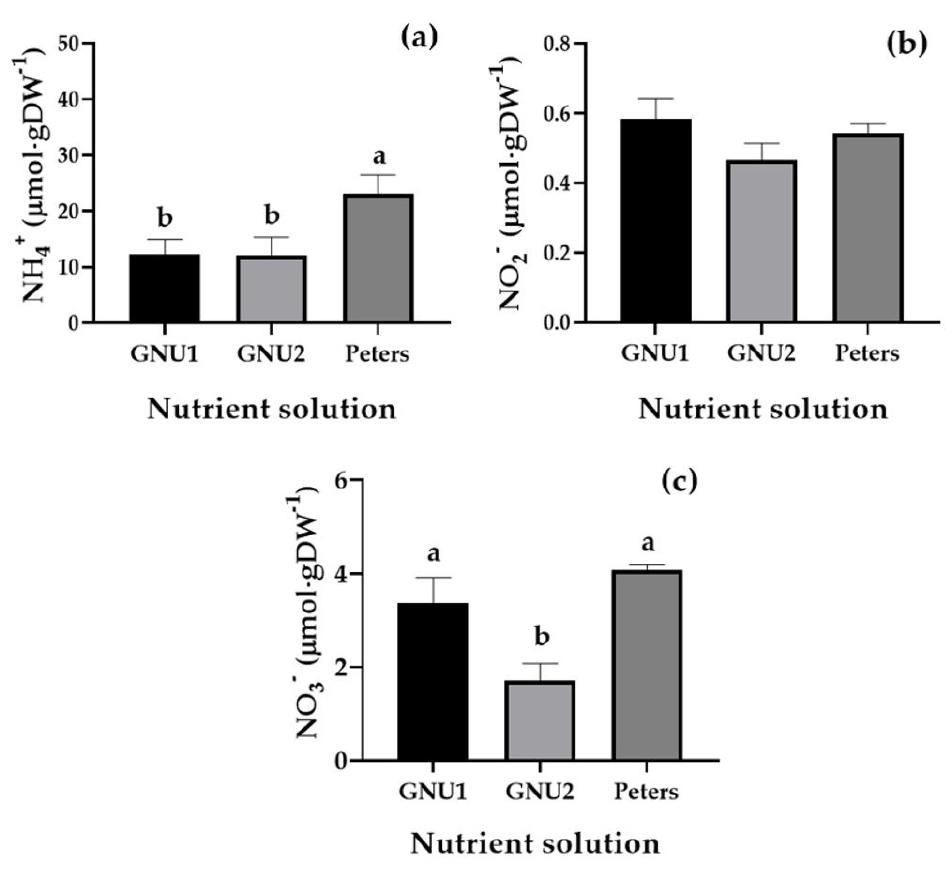
Fig. 8.
Tissue contents of NH4+ (a), NO2− (b), and NO3− (c) in the leaf of Romaine lettuce at 28 days after sowing as affected by nutrient solutions. Peters, GNU1, and GNU2 are the nutrient solutions used in the experiment, and Peters is the commercial nutrient solution. Vertical bars represent SEs of 30 biological replicates (n = 3). Significant differences among treatments are indicated by lower case letters at p ≤ 0.05 according to the Duncan’s multiple range test.
Peters 처리에서 NH4+ 함량이 높게 나타난 것은 앞서 초장, 엽장, 엽폭, 생체중을 비롯하여 뿌리의 색과 뿌리털의 길이 생장이 불량했던 결과와 연관된 것으로 보인다. 쌈추의 경우 양액 내에 공급 질소형태 중 NH4+의 함량을 높여 공급했을 때, 전형적인 암모늄 독성이 나타났는데(Song 등, 2022), 이는 쌈추를 Peters 양액으로 재배했을 때 나타난 결과와 비슷하였다(Noh와 Jeong, 2022). 결론적으로 Peters의 경우 NH4+에 민감한 식물에서 독성이 나타날 수 있고 Peters에서 재배한 로메인상추의 생육이 다른 양액에서 보다 저조한 것은 그 영향으로 볼 수 있다. 조직 내 NO2−의 함량은 처리간 유의한 차이가 없었지만 NO3−의 함량은 GNU2가 GNU1나 Peters에 비해 유의하게 낮은 값을 나타냈다(Fig. 8). 특히 NO2−와 NO3−의 함량이 높을수록 식품안전에 더 큰 영향을 줄 수 있는 만큼 GNU2에서 재배한 로메인상추가 다른 처리에 비해서 더 유리한 것을 확인하였다.
두번째 실험에서는 GNU1과 GNU2를 NO3− : NH4+의 비율(100:0, 83.3:16.7, 66.7:33.3 50:50)을 달리한 총 8종류의 양액을 처리하였다. 앞선 실험과 마찬가지로 파종 다음날부터 발아를 관찰하였다. 발아속도는 GNU2-3처리에서 가장 빨랐고, 평균 발아일수는 GNU2-1, GNU2-3, GNU2-4에서 1.9일로 짧았으며, GNU1-1에서 2.1일로 가장 길었다(Table 2). 발아에너지를 통해 파종 3일차에서 GNU1-4, GNU2-1, GNU2 -2, GNU2-3, GNU2-4 처리에서 모두 발아하였다(Table 2).
Table 2.
Germination rate (GR), mean germination time (MGT), and germination energy (GE) of Romaine lettuce as affected by nutrient solution.
| Nutrient solution (A) |
NO3‒ : NH4+ (%) (B) | Code |
GRy (Seeds per day) | MGT (day) | GE (%) | |
| GE2 | GE3 | |||||
| GNU1 | 100.0:0.0z | GNU1-1 | 7.4 bw | 2.1 a | 3.34 | 86.7 b |
| 83.3:16.7 | GNU1-2 | 7.8 ab | 2.0 ab | 6.67 | 90.0 b | |
| 66.7:33.3 | GNU1-3 | 7.8 ab | 2.0 ab | 6.67 | 90.0 b | |
| 50.0:50.0 | GNU1-4 | 7.8 ab | 2.0 ab | 3.34 | 100.0 a | |
| GNU2 | 100.0:0.0 | GNU2-1 | 8.3 ab | 1.9 b | 10.00 | 100.0 a |
| 83.3:16.7 | GNU2-2 | 7.8 ab | 2.0 ab | 3.34 | 100.0 a | |
| 66.7:33.3 | GNU2-3 | 8.5 a | 1.9 b | 13.33 | 100.0 a | |
| 50.0:50.0 | GNU2-4 | 8.0 ab | 1.9 b | 6.67 | 100.0 a | |
| F-testx | A | * | * | NS | ** | |
| B | NS | NS | NS | * | ||
| A × B | NS | NS | NS | * | ||
zEight treatment solutions were the GNU1 and GNU2 in combination with four levels of NO3−:NH4+ ratio 100:0, 83.3:16.7, 66.7:33.3 and 50:50 and they as subgroups were named as 1, 2, 3 and 4, respectively.
파종 후 28일차에 수확한 식물의 외관을 상부에서 관찰하였을 때, 다른 처리보다 GNU1-1에서 덜 생장하였다(Fig. 9). 측면에서 관찰하였을 때는 GNU1-1에서 상대적으로 왜소하였고 GNU2-2 GNU2-3에서 다른 처리에 비해 비교적 더 강건하게 자란 것으로 관찰되었다(Fig. 9). 뿌리 색은 NH4+ 비율이 높은 GNU1-4와 GNU2-4에서 다른 처리에 비해 어두웠다. 생체중은 GNU1-2, GNU2-1, GNU2-2에서 다른 처리구보다 유의하게 컸으며 GNU1-1에서 가장 작았다(Fig. 10). 엽비중은 GNU2-1에서 가장 높았고 GNU2-2, GNU1-1순이었으며 GNU2의 하°C위 그룹이 GNU1의 하위그룹에 비해서 더 높은 경향을 보였다(Fig. 10). 조직 내 NH4+ 이온 함량은 처리구 간에 유의한 차이가 없었다(Fig. 11). NO2−은 GNU1-3에서 가장 높았고, GNU1-2, GNU1-1 순이었다. NO3−은 GNU1-1에서 가장 높고, GNU1-2에서 두번째로 높았다. 양액 중의 NO3− 농도가 감소함에 따라 조직 내 NO3− 함량이 감소하였고 이는 공급 양액의 NO3−의 농도에 따라 잎 조직의 NO3− 농도가 영향을 받았다고 볼 수 있다. 그러나 GNU2의 하위 그룹 양액에서는 그러한 경향이 나타나지 않았는데 그 이유는 로메인상추의 생장에 필요한 무기원소가 조직 내부에 축적될 잉여분이 적었기 때문인 것으로 보인다. 또한, GNU2-3과 GNU2-4가 GNU2-1과 GNU2-2에 비해 높은 NO3− 함량을 보인 것은 생중량이 상대적으로 작았기 때문에 나타난 ‘집중효과’로 보인다(Chen 등, 2004).
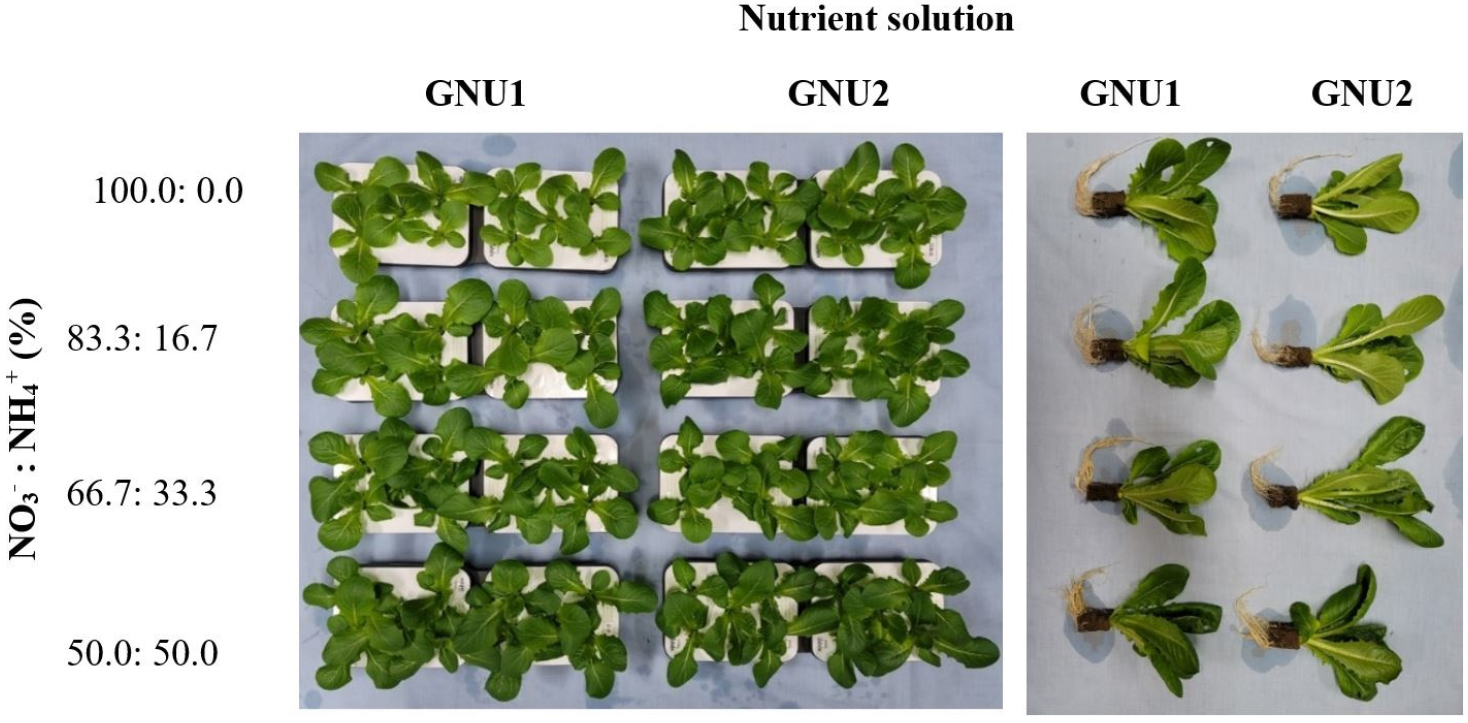
Fig. 9.
Growth of Romaine lettuce at 28 days after sowing as affected by nutrient solution in experiment 2. Eight treatment solutions were the GNU1 and GNU2 in combination with four levels of NO3−:NH4+ ratio 100:0, 83.3:16.7, 66.7:33.3 and 50:50 and they as subgroups were named as 1, 2, 3 and 4, respectively.

Fig. 10.
Fresh weight (a) and specific leaf weight (b) at 28 days after sowing as affected by nutrient solution in experiment 2. Eight treatment solutions were the GNU1 and GNU2 in combination with four levels of NO3−:NH4+ ratio 100:0, 83.3:16.7, 66.7:33.3, and 50:50 and they as subgroups were named 1, 2, 3, and 4, respectively. The vertical bars represent SEs of 30 biological replicates (n = 30). Significant differences among treatments are indicated by lowercase letters at p ≤ 0.05 according to the Duncan’s multiple range test.

Fig. 11.
Tissue contents of NH4+(a), NO2−(b), and NO3− (c) at 28 days after sowing as affected by nutrient solution in experiment 2. Eight treatment solutions were the GNU1 and GNU2 in combination with four levels of NO3−:NH4+ ratio 100:0, 83.3:16.7, 66.7:33.3, and 50:50 and they as subgroups were named 1, 2, 3, and 4, respectively. Vertical bars represent SEs of 3 biological replicates (n = 3). Significant differences among treatments are indicated by lower case letters at p ≤ 0.05 according to the Duncan’s multiple range test.
결론적으로 로메인의 경우 양액 재순환형 저면 관수 수경재배시스템에서 GNU2-2 양액이 적합한 양액이었다. 첫번째 실험에서는 Peters의 EC가 가장 낮았지만 암모늄 독성이 나타나며 생육이 불량했고, GNU1과 GNU2 중 비교적 EC가 낮은 GNU2(1.4mS·cm-1)에서 생육이 더 우수하였다. 서로 다른 EC 값에서 로메인의 생장을 비교했던 다른 연구에서 이와 비슷한 EC 수준인 1.6mS·cm-1(Huett, 1994), 1.4mS·cm-1 (Samarakoon 등, 2006)에서 생체중이 가장 높은 것과 비슷한 결과이며, 이 연구들에서도 본 연구와 마찬가지로 양액의 EC가 높아질수록 생체중이 감소하는 경향을 보였다. 두번째 실험에서는 양액의 이온 강도가 비교적 낮은 GNU2 그룹에서 더 유리한 생장을 보였다. 로메인의 생장은 GNU2-2 양액에서 가장 높은 생체중을 보이면서도 NO3−의 조직 내 함량이 낮았다. 양액의 균형처방으로 인해 EC값으로 단순 비교는 어렵지만, 양액강도가 높을수록 식물 조직 내 질산염 함량이 높아진 기존연구와 비슷한 결과이다(Chung 등, 2005; Kappel 등, 2021). 이는 GNU2 하위 그룹의 낮은 이온 농도로 인해 잉여의 NO3− 가 조직에 축적되는 것을 예방한다는 점에서 식품안전 측면에서 더 유리하였다고 판단된다. 또한 이것은 투입되는 무기양분의 절대량을 줄일 수 있다는 점에서 바람직하다.



